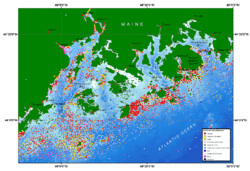Penobscot Bay
| Penobscot Bay | |
|---|---|

Penobscot Bay (Maine)
|
|
| Location | Maine, United States |
| Coordinates | 44°11′14″N 68°55′16″W / 44.18722°N 68.92111°WCoordinates: 44°11′14″N 68°55′16″W / 44.18722°N 68.92111°W |
| River sources | Penobscot River |
| Ocean/sea sources | Atlantic Ocean |
| Max. depth | 145 meters |
| Salinity | approx. 31psu |
| Settlements |
Rockland, Maine Camden, Maine |
Penobscot Bay originates from the mouth of Maine's Penobscot River. 11,000 years ago, at the beginning of the Holocene era, the Gulf of Maine's sea level fell as low as 180 feet (55 m) below its present height. Penobscot Bay was then a continuation of Penobscot River that meandered through a broad lowland extending past present day Matinicus Island. Penobscot Bay is between Muscongus Bay and Blue Hill Bay.
Penobscot Bay and its chief tributary, Penobscot River are named for the Penobscot Indian Nation, which has continuously inhabited the area for more than ten thousand years, fishing, hunting and shellfish gathering in and around the bay and river. A part of the Wabanaki Confederacy, the Penobscot Indian Nation's present reservation includes Indian Island, north of Orono, Maine, and all the islands of Penobscot River above it. Ancient remains of their campsites dating back millennia have been found on the bay's shores and islands. For more on Wabanaki culture and history on the Maine coast, see "Asticou's Island Domain: Wabanaki Peoples at Mount Desert Island 1500-2000,"(National Park Service, 2007)
There are many islands in this bay, and on them, some of the country's most well-known summer colonies. The bay served as portal for the one time "lumber capital of the world," namely; the city of Bangor.
Penobscot Bay has many working waterfronts including Belfast, Maine, which is home to custom boat builder Front Street Shipyard. Other working waterfronts include Rockland, Rockport, and Stonington.
Penobscot Bay has been the receiving waters for sewage waste and industrial waste discharges from bay and river towns since the 19th century. Discharge treatment was primarily dilution until the mid 20th century when the federal government began requiring communities and businesses of all states to meet water pollution control standards.
...
Wikipedia
